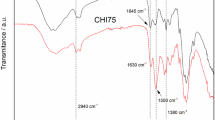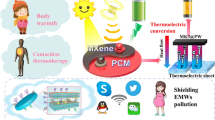Abstract
Microencapsulation of phase change materials (PCMs) is an attractive opportunity for broadening their applications. In this respect, a novel encapsulating polymer, ethyl cellulose (EC) was used to entrap n-hexadecane (HD) PCM by an emulsion-solvent evaporation method. Emulsifiers strongly influenced the size and morphology of the forming EC–HD composite microcapsules, and they also had a great impact on their thermal properties. All of the three emulsifiers were suitable to prepare quasi core–shell microparticles, though the high porosity of shells resulted in serious leakage in composites prepared by Tween 80, and permeability of particles manufactured by poly(vinyl alcohol) (PVA), as can be stated from scanning electron microscopy and differential scanning calorimetry analysis. Interfacial tension measurements and spreading coefficient analysis enabled the prediction of preparation conditions for usable core–shell microcapsules. Volume-weighted mean diameters of the microparticles were 319, 92 and 85 μm formed by Tween 80, PVA and poly(methacrylic acid sodium salt) (PMAA), respectively. A significantly higher HD content and latent heat storage capacity could be achieved using PVA and PMAA than with Tween 80. The thermal cycling test indicated good thermal reliability of microcapsules prepared by PMAA, while the energy-storing capacity of composites prepared by PVA decreased substantially, and a dramatic reduction was found in microparticles using Tween 80.






Similar content being viewed by others
References
Li MG, Zhang Y, Xu YH, Zhang D (2011) Effect of different amounts of surfactant on characteristics of nanoencapsulated phase-change materials. Polym Bull 67:541–552
Rogers TL, Wallick D (2012) Reviewing the use of ethylcellulose, methylcellulose and hypromellose in microencapsulation. Part 3: Applications for microcapsules. Drug Dev Ind Pharm 38:521–539
Zhang GH, Bon SAF, Zhao CY (2012) Synthesis, characterization and thermal properties of novel nanoencapsulated phase change materials for thermal energy storage. Sol Energy 86:1149–1154
Mirabedini SM, Dutil I, Farnood RR (2012) Preparation and characterization of ethyl cellulose-based core–shell microcapsules containing plant oils. Colloid Surf A 394:74–84
Badulescu R, Vivod V, Jausovec D, Voncina B (2008) Grafting of ethylcellulose microcapsules onto cotton fibers. Carbohydr Polym 71:85–91
Phadungphatthanakoon S, Poompradub S, Wanichwecharungruang SP (2011) Increasing the thermal storage capacity of a phase change material by encapsulation: preparation and application in natural rubber. ACS Appl Mater Interfaces 3:3691–3696
Smith MC (2009) Microencapsulated phase change materials for thermal energy storage. PhD thesis. The University of Auckland. http://researchspace.auckland.ac.nz/handle/2292/5603. Accessed 17 July 2013
Loxley A, Vincent B (1998) Preparation of poly(methylmethacrylate) microcapsules with liquid cores. J Colloid Interface Sci 208:49–62
Torza S, Mason SG (1970) Three-phase interactions in shear and electrical fields. J Colloid Interface Sci 33:67–83
Luz JAM, Soares A (2012) Interfacial tension from profile of the pendant drop versus du Noüy’s Method. XIII. In: International Mineral Processing Symposium, E-Book of Abstracts, pp 297–303
Brandrup J, Immergut EH, Grulke EA (2003) Polymer handbook, Fourth edn, VI. Wiley, Hoboken, p 533
Feczkó T, Kokol V, Voncina B (2010) Preparation and characterization of ethylcellulose-based microcapsules for sustaining release of a model fragrance. Macromol Res 18:636–640
Feczkó T, Varga O, Kovács M, Vidóczy T, Voncina B (2011) Preparation and characterization of photochromic poly(methyl methacrylate) and ethyl cellulose nanocapsules containing a spirooxazine dye. J Photochem Photobiol A 222:293–298
Feczkó T, Kovács M, Voncina B (2012) Improvement of fatigue resistance of spirooxazine in ethyl cellulose and poly(methyl methacrylate) nanoparticles using a hindered amine light stabilizer. J Photochem Photobiol A 247:1–7
Pisani E, Fattal E, Paris J, Ringard C, Rosilio V, Tsapis N (2008) Surfactant dependent morphology of polymeric capsules of perfluorooctyl bromide: Influence of polymer adsorption at the dichloromethane–water interface. J Colloid Interface Sci 326:66–71
Zhang X, Tao X, Yick K, Wang X (2004) Structure and thermal stability of microencapsulated phase-change materials. Colloid Polym Sci 282:330–336
Zhang, X (2005) Fabrication, structures and properties of nano/microencapsulated phase change materials, thermo-regulated fibres and fabrics. PhD thesis. The Hong Kong Polytechnic University. http://repository.libpolyu.edu.hk/jspui/handle/10397/2299. Accessed 17 July 2013
He B, Martin V, Setterwall F (2004) Phase transition temperature ranges and storage density of paraffin wax phase change materials. Energy 29:1785–1804
Zhang T, Wang Y, Shi H, Yang W (2012) Fabrication and performances of new kind microencapsulated phase change material based on stearic acid core and polycarbonate shell. Energy Convers Manage 64:1–7
Sarier N, Onder E (2007) The manufacture of microencapsulated phase change materials suitable for the design of thermally enhanced fabrics. Thermochim Acta 452:149–160
Acknowledgments
We acknowledge the support of the Hungarian state and the European Union TAMOP-4.2.2A-11/1/KONV-0443560/130 and TAMOP-4.2.1-08/1-2008-0007. This paper was also supported by the János Bolyai Research Scholarship of the Hungarian Academy of Sciences. Ethyl cellulose supply is courtesy of Dow Deutschland Anlagengesellschaft mbH. We are grateful to Dr. Gyula Kiss for supplying the tensiometer for the measurements.
Author information
Authors and Affiliations
Corresponding author
Rights and permissions
About this article
Cite this article
Feczkó, T., Kardos, A.F., Németh, B. et al. Microencapsulation of n-hexadecane phase change material by ethyl cellulose polymer. Polym. Bull. 71, 3289–3304 (2014). https://doi.org/10.1007/s00289-014-1250-y
Received:
Revised:
Accepted:
Published:
Issue Date:
DOI: https://doi.org/10.1007/s00289-014-1250-y




